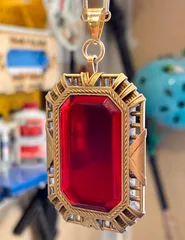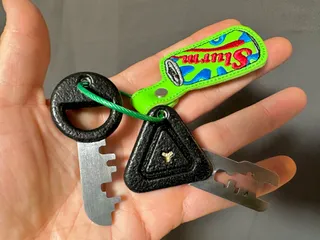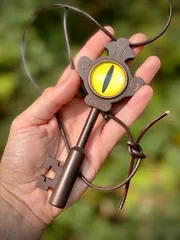Magnetic Drawer with Accessory Rails
Description
PDFThis a 235mm x 152.4mm x 50.8mm (9.25" x 6" x 2") drawer that you can install under a desk, table, or shelf. The drawer does not have a traditional rail or track; it works with magnets! The drawer and rails are held together by eight 30mm x 3mm magnets.
The magnets hold the drawer open and shut. You can easily remove the drawer to take it with you and slide it back in when you're done. The magnets pull the drawer into alignment. As the drawer closes, the front and rear magnets attract each other, and the drawer shuts itself in a most satisfying way.
The rails support customizable accessories that attach securely with friction or the same magnets. You can stick metal objects (e.g., key chains full of key fobs, etc.) to the rails or use one of the accessory plates to add hooks, pen holders, and other things. I have included an assortment of options, but you can design your own as well.
I also included a blank attachment base. Use it as a foundation in Meshmixer to sculpt a new attachment or print several in different colors to use as decoration on unused attachment points :)
You only need screws to attach the rails to your desk. You can optionally use two M3 screws to attach a faceplate to the drawer's front. You can also use glue or attach your own handle, knob, paracord, or whatever you like directly to the drawer.
Printing & Purchasing
Print these parts:
- 1 x Drawer
- 1 x Rail R
- 1 x Rail L
- 1 x Face Plate (of your choice)
- <=6 x Attachments
Purchase a set of 30mm x 3mm magnets. You need eight (8) magnets for the basic assembly.
Test fit the attachments over the attachment points on your rails. They fit snugly enough to hold light objects without needing a magnet. If your attachments fit loosely or you want them to keep heavier things, add one (1) magnet for every attachment you want to add. The magnets can hold up to 18lbs. With the thin plastic between them, that force is reduced, but they'll easily hold your headphones and other everyday items.
Any attachment blanks should not need a magnet, but the blanks have slots if you want to use them to store extra magnets for future attachments.
Note: If you search Amazon for 30mm x 3mm magnets, you may see results for "1.26in x 1/8in" magnets. The sizing is similar, but 2mm too wide!
Assembly
Each part has a magnet slot that is oriented so the magnets won't fall out, even if a magnet has a loose fit inside the slot. Collect your parts and magnets and follow these simple steps:
- Start with one side of the drawer and insert magnets into the two slots. Make sure their polarities are oriented in the same direction.
If you make a mistake, there is a cut-out inside the drawer to touch the magnet and slide it out of the slot.
Note: Take care when working with the magnets. These magnets are powerful and can quickly fly out of your hand towards another magnet. They will shatter if you let them smash into each other. - Take the rail for that side and insert a magnet into the front and back slots that align with the drawer's magnets.
The magnet slots should point towards the back of the drawer for aesthetics; however, they'll likely be covered by an attachment.
You want the rail attached to the drawer, so align the magnets with this in mind. If you make a mistake, there is a small hole where you can use a wire or rod to push the magnet out of the slot. - Now mirror the magnets to the other side of the drawer and second rail. Take a magnet, hold it inside the drawer, and turn it so the installed magnets repel the magnet in your hand. This is the magnet face you want pointing towards the opposite drawer magnet.
Put another way: the magnet faces opposite each other in the drawer's slots should be the same polarity.
If done correctly, your attachments will magnetize to any attachment point on either side without requiring you to flip a magnet. - Slide a magnet into each attachment. The attachment should fit snugly over any of the attachment points. The magnet will secure it. The walls separating the magnets are thin, so the magnets have a strong attraction. The attachments can hold headphones and heavy key chains without an issue.
- If you want to use the center attachment points for headphones and other heavier objects, insert magnets into those slots. Don't do this unless you want to use the center attachment points.
- Attach a face plate to the front of the drawer using two M3 screws. The face plate must sit flush with the top of the drawer and rails. The included plates extend below the drawer for a finger hold.
If you printed the face plate labeled for threaded inserts, push an insert into each hole before attachment.
Accessories
I designed several attachments to suit my needs. There are six attachments:
Accessory Blank
The blank is just the base used for all other attachments. Use this model to design your own attachments or print them to cover your unused attachment points.
Accessory Pencil Bandolier
I measured my collection of pens and pencils and found they were all around 10-10.8mm thick. The holes in this accessory are 11mm and can hold your favorite or most used writing utensils.
The holes are also the perfect size for the cylindrical pencil led cases made by Kurotoga. The Kurotoga caps have little nubs that make them slightly bigger than 11mm, so the cases slide into the holes and stop at the cap.
Also, if your pens or pencils have metal bodies, the magnets will pull them inside. My Pentel GraphGear 1000 pencils fit neatly inside the holes. Once inserted halfway, the magnet pulls the pencil inside. It's a fun, satisfying effect for a little pencil organizer.
Accessory Bin
Adding a bin to this drawer is problematic because it sits against the bottom of a desk or shelf. You can't easily look inside a deep bin or lift something out. This bin is shallow and more of a tiny shelf. It's perfect for little things you need nearby but not on your desk.
I use it to keep the cloth for cleaning my glasses out of the way.
Accessory Hook
It's a hook; not much else to about this one. The hook is 21.5mm deep and wide enough to hold headphones while also holding smaller or thinner items like cables and key chains.
Accessory Rail
The rail is like the hook but straight. It has a small lip at the end to keep things from slipping off. I prefer this over the hook for items I need to frequently use, like my YubiKeys.
Accessory Headphones
This accessory is designed with headphones in mind. It has a wide curved made for holding padded headphones like the Sony WH-1000XM3.
Add a magnet for a strong hook that will hold even the heaviest headphones and keep them out of the way and off your desk when you don't need them.
Face Plate Notes
There are two versions of each faceplate. Any faceplate with (Insert) in the name of the file has 4mm holes. These holes accept M3 threaded press-fit inserts like these:
https://www.mcmaster.com/threaded-inserts/threaded-insert-type~press-fit/thread-size~m3/
If you plan to thread the screws into plastic, use the other version of your desired faceplate. The other versions have 3mm holes suitable for M3 screws.
If you want to create your own, the drawer's front is 157.2mm x 50.8mm. The rails are 4mm thick, so a faceplate should be 165.2mm wide (at a minimum) to cover the drawer and rails.
See the Fusion 360 archive file for more details.
There is a 2mm lip at the bottom of the smaller included plates. You can use this as a grip, but I recommend attaching some sort of handle. I chose a simple leather strap that matched my notebooks (as pictured in the image gallery), but you can use cabinet hardware, paracord, knobs, or just about anything else.
You can also make larger plates with built-in grips or handles. I included some of those as well.
The faceplate named Face Plate - Mold.stl is designed as a good starting point for a simple one-part silicone mold. You can create a faceplate using resin or epoxy as I did in the photos. It is a basic plate with rounded corners and a fillet along the back edges. The front edges are not filleted because it is the top of the mold.
Apply some hot glue along the front of the plate's outer edges to attach it to some wood, cardboard, or foam core. Build a short box around the plate and pour in your silicone. Once cured, you should have an easy mold to create new faceplates.
This isn't the only faceplate you could use to make a mold, but I wanted to make it simple for anyone who wanted to try it for their first mold.
Print instructions
All parts are in the proper position for printing. You will not need to change orientation or use any support material. For best results, print the parts in PLA or PETG.
Print the parts using a 0.4mm or 0.6mm nozzle. I recommend using a 0.6mm for the sake of print time. The drawer is the biggest piece and requires ~12 hours of print time with a 0.4mm nozzle. You can print it in ~7-8 hours with a 0.6mm nozzle and default settings for a Prusa MK3S.
I designed all walls and other features to be cleanly divisible by both 0.4 and 0.6, so you won't get any ugly artifacts by choosing your preferred nozzle.
Use a 0.2mm or 0.3mm layer height for best results. I printed my drawers with 0.3mm layers and a 0.6mm nozzle for optimal print time and strength.
You want the rails to be straight, so do what you need to do to combat any lifting or warping, if you experience any with your printer. If you find the rails are lifting near the ends, enable a 5mm brim or use an adhesive like Magigoo to help them stay stuck to the bed.
Tags
Model origin
The author hasn't provided the model origin yet.




